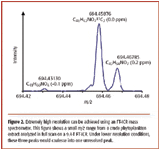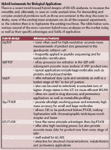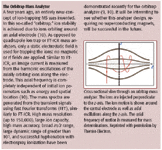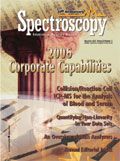Tutorial — Mass Analyzers: An Overview of Several Designs and Their Applications, Part II
Spectroscopy
The second installment of this two-part series illustrates further technical principles and applications of the most common mass analyzers used in bioanalytical laboratories today, as well as novel techniques and mass analyzer designs. Examples are based upon the authors' research in small molecule applications.
Mass spectrometry (MS) instrumentation has undergone several improvements over the years, including increased sensitivity, ease-of-use, and possibilities for more sophisticated and time-efficient experiments. This article illustrates the technical principles and typical applications of the most common mass analyzers used in bioanalytical laboratories today. There are four basic types of mass analyzers found in modern MS: time-of-flight (TOF), quadrupole and a recent derivative, quadrupole linear ion trap (LIT), which were covered in Part I of this series (1), and quadrupole ion trap (QIT), and Fourier transform ion cyclotron resonance (FT-ICR), which are discussed in this installment. Rather than simply explaining the underlying physical principles, we concentrate on each mass analyzer's characteristic features, their limitations, and their applications. In addition, several unique techniques and unusual or exotic mass analyzer designs are highlighted throughout the text. We have chosen examples from our own research in small molecule applications. Therefore, some interesting recent hybrid designs (with mostly proteomics applications) only are described briefly.
The Quadrupole Ion Trap (QIT) Analyzer
The analyzers described in Part I of this article are ion beam-type instruments (except for the linear ion trap). In this installment, we will concentrate on ion-trapping devices, which allow the storage of ions using electric potentials (ion trap) or magnetic fields (ion cyclotron resonance, ICR) with subsequent mass analysis in the same space. This section explains the principles of quadrupole ion trap (QIT) MS.
The ion trap can be envisioned as a regular linear quadrupole wrapped around itself. It is composed of two end-cap electrodes and one ring electrode. By applying appropriate potentials on these electrodes, a pseudo-potential well, to which ions are confined, is formed within the trap, and ions can be stored for long intervals in this instrument. The ion trap is kept at high pressures relative to other mass analyzers, because of the presence of a damping gas, usually helium, which causes collisional cooling of the analyte ions with subsequent confinement in the center of the trap. The usual pressure inside the trap is ~10-3 versus 10-7 -10-11 torr for other mass spectrometers.
Mass analysis in the ion trap is achieved by means of the so-called mass-selective instability scan or by resonance ejection. In the mass selective instability scan, ions of specific m/z values are ejected from the trap selectively by linearly increasing the rf amplitude on the ring electrode. Detection of the ions occurs following the ejection process. The resonance ejection technique extends the mass range of the ion trap by exciting the ions in the trap via a supplemental potential applied to the end caps. If the amplitude of this additional potential is large enough, ions are ejected from the ion trap at ring electrode rf voltages lower than those required for the mass selective instability scan.
Furthermore, specific scans can be used selectively to eject all unwanted ions from the trap. A selected precursor, for instance, can be isolated by applying a broadband waveform consisting of all frequencies except that of the secular frequency of the ion of interest. It is important to realize that an experiment on an ion trap is composed of several steps occurring sequentially, in the same space. This chain of events is called a microscan. The separated time periods include ion injection, isolation, excitation, and analysis. In addition, very often an initial pre-scan is performed to determine the ideal injection time, thereby reducing space charge effects. This is important because a fundamental limitation of the ion trap is the dependence of ion stabilities upon the number of ions present in the trap. As the amount of ions is increased, space charging becomes an important factor. The electrostatic field is distorted by having too many ions in the trap, thus causing broadening of peaks, mass scale shifts, and loss in sensitivity. Eventually, ions are no longer trapped when the ion density becomes too large. Therefore, the pre-scan assesses the amount of ions entering the trap, and certain parameters, such as the injection time, are adjusted consequently to correct for possible space charging. Interestingly, quadrupole linear ion traps (1) also exhibit space charge effects, but they have larger ion storage capacity (2).
After the ions are injected into the trap from the source, a suitable rf voltage on the ring electrode confines them to stable trajectories. An isolation scan can be performed subsequently in order to accumulate a specific ion or a range of ions selectively. The next possible step is ion excitation, in the case of tandem MS. Finally, ions are analyzed by ejection from the ion trap to the detector through openings in the end caps. Figure 1 exhibits representative scan functions in an ion trap. The type of scan dictates the length of time spent on each step. The differences in the operation of ion traps and quadrupoles have a direct effect upon the duty cycle of the instruments, and we see that ion traps are very sensitive in a full-scan experiment, but do not gain very much sensitivity, as one would imagine, using the selected ion monitoring (SIM) mode. On the other hand, a SIM experiment in a quadrupole instrument has much higher sensitivity than it does for a full scan experiment (1).

Figure 1. The events during an QIT micro-scan are: 1. ion injection, 2. isolation, 3. excitation, 4. mass analysis. (a) Full-scan MS: a waveform is used to eject unwanted ions from the trap and to isolate a mass range of interest during ion injection; the rf voltage is ramped during mass analysis to eject the ions out of the trap sequentially. (b) SIM: a waveform is used to isolate a narrow m/z range of interest [the waveform has a notch present, corresponding to that of the secular frequency of the ion of interest] for selective accumulation. All unwanted ions are removed by resonant ejection; the rf ramping during mass analysis is very short for the limited m/z range. (c) MSn: a waveform is used to isolate only the precursor ion; the resonance excitation step dissociates the precursor ion using an auxiliary rf voltage at the end caps. Product ions are analyzed subsequently.
Further important differences between ion trap and quadrupole MS are seen in tandem MS experiments. The QIT can be described as a tandem-in-time instrument (versus tandem-in-space for a triple quadrupole) and allows multiple stages of tandem mass spectrometry (MSn ), whereby precursor ions can be activated selectively and dissociated to form product ions. The product ions are detected by subsequent ejection from the trap. The ion activation of the isolated precursor usually is achieved via "on-resonance" excitation by applying a small (tickle) potential, corresponding to the secular frequency of the ion, across the end caps. As ion activation times in the order of tens of milliseconds can be used without significant ion losses, multiple collisions occur during the excitation period. Because of this relatively long time-scale, this excitation technique falls in the category of so-called "slow heating" processes (3). For a slow-heating process, excitation in an ion trap still is quite fast, due to the high pressure of helium present in the trap. There are other slow-heating methods, such as "sustained off-resonance irradiation" (SORI, see next paragraph) with longer excitation periods. MSn experiments are quite advantageous for the elucidation of fragmentation pathways, which in turn aid in the analysis of CID spectra for identifying molecular structures for precursors as well as product ions. The results are, in principle, similar to those obtained in quadrupole linear ion traps.

Figure 2. Extremely high resolution can be achieved using an FT-ICR mass spectrometer. This figure shows a small m/z range from a crude phytoplankton extract analyzed in full scan on a 9.4-T FT-ICR. Under lower resolution conditions, these three peaks would coalesce into one unresolved peak.
Sometimes, mass spectrometrists point out that ion traps yield CID spectra with only a limited number of fragment ions, in comparison to triple quadrupole spectra. This is, in fact, quite true and often one needs to conduct several stages of MSn to generate a sufficient number of product ions. The reason for this limitation is, of course, based upon the resonance excitation used for ion activation, which does not excite the product ions, because of their different secular frequencies (that is, they are no longer "in resonance" with the excitation frequency and therefore do not pick up further energy). In fact, molecules that tend to cleave off a large number of unspecific small molecules (mostly H2O) are sometimes difficult to analyze by MSn , because structurally informative backbone cleavages are hard to reach. The selective activation procedure, however, offers a tremendous advantage with its ability to yield exact relationships between precursor and product ions, allowing the "genealogical" mapping (4) of the entire fragmentation process. Triple quadrupole CID experiments, on the other hand, are much less selective, as the product ions tend to undergo further collisions, to give additional second or even higher-generation product ions. The linked information between precursor and different generation product ions is difficult to determine in such cases.
The analytical figures of merit of QIT mass spectrometers are somewhat comparable to quadrupole mass analyzers (that is, mass ranges of up to m/z 4000 can be analyzed, at unit mass resolution). Higher mass resolution can be achieved with special slow scanning routines, for much smaller m/z ranges. The detection sensitivity, as outlined earlier, generally is very good in the full-scan mode because of the ion-trapping abilities. The duty cycle in the SIM or MRM modes of the QIT-MS is much lower than on the quadrupole MS, because of the significant overhead contributions to the microscan sequence (Figure 1). The sensitivity enhancements in the SIM mode in comparison to the full scan mode, therefore, are not very pronounced.

Mass Resolution Versus Mass Accuracy
Finally, the QIT also has been combined recently with a TOF analyzer (5). In QIT-TOF, the QIT is used as a precursor ion selection and/or MSn stage, prior to high-resolution, accurate mass TOF analysis. Such an instrument allows accurate mass data to be obtained for product ions of each individual stage of MSn . This instrument originally had been available only with a MALDI source; therefore, most current applications include large molecules such as proteins and polysaccharides.
The Fourier Transform Ion Cyclotron Mass Analyzer
FT-ICR MS has experienced a remarkable increase in use by analytical chemists recently. This instrument was employed historically for fundamental physics and physical chemistry applications. Recently, however, new developments such as efficient ion-transport devices have allowed the use of external ionization sources (particularly ESI and MALDI), significantly increasing the versatility of FT-ICR mass spectrometers. Furthermore, quadrupole and linear ion-trap analyzers have been implemented for precursor ion selection and collisional activation, before FT-ICR mass analysis. Consequently, FT-ICR has become an invaluable tool for biological MS, primarily for its flexibility in ion-activation techniques available and its extremely high resolution and mass accuracy.
While the principles of mass analysis by ICR date back to 1932, it was not until 1974 that Marshall and Comisarow (6) added the use of Fourier transform pulse techniques to ICR. Before we illustrate the unique properties of FT-ICR MS, a basic description of this analyzer allows one to understand how it achieves these important advantages over other instruments. For readers interested in a more thorough treatment of ICR fundamentals, we suggest reference 7.
In the homogeneous magnetic field B of the ICR cell, the Lorentz force FL subjected onto an ion of velocity v entering the magnetic field, will bend the ion's path into a circular motion, as follows:

where v and B are vectors, perpendicular to each other, m is the mass of the ion, q is the charge, r is the ion's radius, and Fc is the balancing centripetal force. If the ion is under extremely low pressure conditions, it does not experience any collisions with residual gas molecules in the cell. Consequently, the speed of an ion in the FT-ICR cell is constant. With ω= v/r, it follows that the angular velocity is given by

This is the fundamental equation for FT-ICR, where the ion's m/z value can be directly measured by its ion cyclotron frequency ωc. Note that ions of the same m/z value have equal ωc and no dependence on the ion's initial velocity upon injection into the cell (that is, no energy focusing is required for the precise determination of m/z). The ion's cyclotron frequency ranges from kHz to MHz values, depending upon its mass, for small organic molecules to biomolecules in the kDa range. It also is informative to look at the radius of the cyclotron motion, r = mv/qB (see Equation 1). As illustrated by Marshall and coworkers (7), cyclotron radii between 0.08 mm for m/z 100 to 1 cm for m/z 10,000 are assumed by the ions at room temperature and a magnetic field strength of 3 T (tesla).
In order to measure the cyclotron frequency, and thus the mass, of an ion (via Equation 2), ions must be accelerated coherently to a new radius. This is required because initially, not all ions are at the same point on their circular orbits. Therefore, their motions are incoherent, and their frequencies thus cancel out and cannot be measured. For all ions of a specific m/z value to become coherent, an rf field, rotating with the ICR frequency of the specific ion, is applied. After this excitation, the radius of the ion no longer depends upon its m/z value (7):

where Vp-p is the peak-to-peak magnitude of the rf electric field, d is the distance between the plates, and Texcite is the excitation time. Note that by exciting all ions of different m/z values with a broadband rf field, they all end up at the same radius after the excitation process. The resulting ions all have become spatially coherent, but ions of different m/z values still have a characteristic cyclotron frequency. Each m/z value can be differentiated based upon the speed at which they orbit the common radius occupied by all ions.
A unique and quite interesting feature of FT-ICR mass spectrometers is the way the frequency measurement is performed. FT-ICR analyzers do not have a detector, where ions are discharged physically, as is the case with most other mass spectrometers. Rather, detection is based upon measuring the image current that individual ion packages induce when they pass the detector plates repeatedly, at their cyclotron frequencies. In a typical FT-ICR experiment, the ions in the cell are excited simultaneously, and a composite image current for all ions is measured. Next, this transient signal is converted from the time domain to the frequency domain using a fast Fourier transform algorithm. The individual frequencies then can be transformed to m/z values by means of Equation 2. Note that this method of detection is non-destructive. Ions can be measured for extended transient times, if required, thereby increasing the mass resolution. The transient signals diminish eventually, because of collisions in the ICR cell slowing down the orbiting ions.

Hybrid Instruments for Biological Applications
It is evident that the strength of the magnetic field is an important factor in several parameters. First, the initial radius of an ion is inversely proportional to B, so that for a higher magnetic field, a higher mass range can be analyzed. Ions of larger m/z occupy larger radii and there is a mass range limit based upon the size of the ICR cell and the magnetic field. Furthermore, as B increases, so does the cyclotron frequency of an ion, indicating that higher magnetic fields yield higher mass resolution. However, there is a reduction in the lower limit of m/z values with a higher magnetic field, because their frequencies become correspondingly higher and thus more difficult to measure. The most striking feature of FT-ICR MS is its outstanding mass resolution, significantly larger than any other MS technique available currently. (Figure 2 shows an illustrative example for biotoxins; additional detail is given in the sidebar "Mass Resolution Versus Mass Accuracy.") As seen with quadrupole ion traps, FT-ICR also is affected by space charge effects, if too many ions are present in the cell. The interactions between the ions lead to dephasing of the ion cloud and peak coalescence.
As mentioned earlier, one of the primary advantages of FT-ICR is the flexibility in ion activation techniques for MS-MS experiments available. As isolation and excitation take place in the same confined space, this instrument belongs to the tandem-in-time category. SORI often is applied for collisional activation in FT-ICR instruments. In SORI, a neutral gas pulse is introduced into the ICR cell and the precursor ion is excited at a frequency slightly higher than the natural cyclotron frequency. Ions undergo multiple acceleration/deceleration cycles as they increase and decrease their orbit radii repeatedly in the FT-ICR cell before dissociation takes place. The activation times often are in the hundreds of milliseconds, sometimes up to seconds, and a large number of collisions take place. This approach is somewhat similar to quadrupole ion trap MSn experiments. An alternative to SORI is infrared multiphoton dissociation (IRMPD), which is available for all commercial FT-ICR instruments. IRMPD activates ions in the ICR cell by irradiation with a low-power CO2 infrared laser (10.6 µm) for tens to hundreds of milliseconds per experiment, resulting in the stepwise absorption of photons, followed by subsequent dissociation of the ion. This process is rather non-selective, therefore, all trapped ions are excited and secondary product ions also can be observed. This feature of IRMPD can be convenient, because the resulting spectra often are similar to low-energy CID spectra measured on triple quadrupole instruments (8). Finally, a fundamentally different technique of activation also is available on all commercial FT-ICR instruments, electron capture dissociation (ECD). ECD involves the capture of low-energy electrons, with charge-state reduction and subsequent fragmentation. It is therefore only applicable to multiply charged cationic species, usually peptides or proteins. ECD is assumed to occur much faster than dissociation in other activation techniques, permitting the occurrence of direct bond cleavages only.

The Orbitrap Mass Analyzer
As with other hybrid mass spectrometers, MS-MS experiments are conducted increasingly outside the ICR cell, either with a linear ion trap or a Qq arrangement, coupled to the FT-ICR mass analyzer (see the sidebar "Hybrid Instruments for Biological Applications"). They offer increased compatibility with fast chromatography runs, as ion activation experiments directly in the ICR cell often take too long to be compatible with chromatography experiments.
Summary and Outlook
In this tutorial, we have presented a short overview of the operating principles and selected applications for the most common mass analyzers used in biological MS today, namely TOF, quadrupole, ion trap, and FT-ICR. As illustrated, the way these analyzers function and their characteristic features are quite different. The TOF analyzer is an ideal match for pulsed-ion sources such as MALDI. Because of its high speed, it also is very useful for extremely fast chromatography applications. It offers high transmission efficiency and a very high mass range. On the other hand, the TOF has limits with respect to duty cycle, dynamic range, and precursor ion selection in MS-MS. Quadrupoles are rugged and versatile. They can be used as mass filters, ion guides, and collision cells. On the other hand, hyphenation with pulsed-ionization sources is less than ideal and their resolving power is limited. Quadrupole ion traps offer high sensitivity in the full-scan mode as well as the ability to perform multiples stages of MS-MS. Similar to quadrupoles, the resolving power is limited. In addition, careful tuning of multiple operating parameters is required to avoid space charge effects, to obtain meaningful MS-MS spectra, and to use it in quantitative applications. Finally, the FT-ICR offers the highest resolving power and mass accuracy of any analyzer available today. Because the ion-detection method is non-destructive, remeasurements for extremely high sensitivity, resolution, and accuracy are possible readily. FT-ICR is very flexible with respect to ion-activation techniques as well. To obtain reliable results, however, it requires careful adjustment of many operational parameters. The hyphenation with chromatography is more complicated because the scan sequences for high-resolution spectra can be time-consuming, sometimes too slow for acquiring a sufficient number of data points across chromatographic peaks. For all the analyzers, we also have shown that there is an increasing trend toward hybrid designs to increase versatility by combining the intrinsic advantages of the individual analyzers.
Finally, we cannot finish this article without mentioning an exciting new type of mass spectrometer that has recently emerged, promising resolving powers similar to FT-ICR without the need for superconducting magnets. This mass analyzer is called the orbitrap, and its operating principles are summarized in the sidebar "The Orbitrap Mass Analyzer."
References
1. D. Volmer and L. Sleno, Spectroscopy 20(11), 20–26 (2005).
2. D.J. Douglas, A.J. Frank, and D. Mao, Mass Spectrom. Rev. 24, 1 (2005).
3. S.A. McLuckey and D.E. Goeringer, J. Mass Spectrom. 35, 461 (1997).
4. R.J. Strife, L.C. Robosky, G. Garret, M.M. Ketcha, J.D. Shaffer, and N. Zhang, Rapid Commun. Mass Spectrom. 14, 250 (2000).
5. B. Warscheid, K. Jackson, C. Sutton, and C. Fenselau, Anal. Chem. 75, 5608 (2003).
6. M.B. Comisarow and A.G. Marshall, Chem. Phys. Lett. 25, 282 (1974).
7. A.G. Marshall, C.L. Hendrickson, and G.S. Jackson, Mass Spectrom. Rev. 17, 1 (1998).
8. L. Sleno, D.A. Volmer, B. Kovacevic, and Z.B. Maksic, J. Am. Soc. Mass Spectrom. 15, 462 (2004).
9. Q. Hu, R.J. Noll, H. Li, A. Makarov, M. Hardman, and R.G. Cooks, J. Mass Spectrom. 40, 430 (2005).
10. M. Hardman and A.A. Makarov, Anal. Chem. 75, 1699 (2003).
11. J.H. Gross. Mass Spectrometry (Springer, Berlin Heidelberg, 2004).
Dietrich Volmer is a senior research scientist at the Institute for Marine Biosciences in Halifax, Nova Scotia, Canada. Lekha Sleno is a Ph.D. student in Dr. Volmer's group. E-mail: Dietrich.Volmer@nrc-cnrc.gc.ca

High-Speed Laser MS for Precise, Prep-Free Environmental Particle Tracking
April 21st 2025Scientists at Oak Ridge National Laboratory have demonstrated that a fast, laser-based mass spectrometry method—LA-ICP-TOF-MS—can accurately detect and identify airborne environmental particles, including toxic metal particles like ruthenium, without the need for complex sample preparation. The work offers a breakthrough in rapid, high-resolution analysis of environmental pollutants.
The Fundamental Role of Advanced Hyphenated Techniques in Lithium-Ion Battery Research
December 4th 2024Spectroscopy spoke with Uwe Karst, a full professor at the University of Münster in the Institute of Inorganic and Analytical Chemistry, to discuss his research on hyphenated analytical techniques in battery research.
Mass Spectrometry for Forensic Analysis: An Interview with Glen Jackson
November 27th 2024As part of “The Future of Forensic Analysis” content series, Spectroscopy sat down with Glen P. Jackson of West Virginia University to talk about the historical development of mass spectrometry in forensic analysis.
Detecting Cancer Biomarkers in Canines: An Interview with Landulfo Silveira Jr.
November 5th 2024Spectroscopy sat down with Landulfo Silveira Jr. of Universidade Anhembi Morumbi-UAM and Center for Innovation, Technology and Education-CITÉ (São Paulo, Brazil) to talk about his team’s latest research using Raman spectroscopy to detect biomarkers of cancer in canine sera.